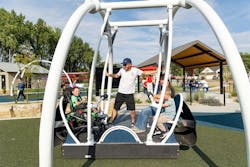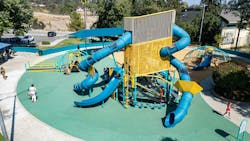Sliding Into Continuous Improvement at Playground Manufacturer Landscape Structures
Key Highlights
- A culture of continuous improvement allows Landscape Structures to innovate effectively, making playgrounds that inspire and challenge children of all abilities.
- Product design improvements are driven by real-world feedback from kids and caregivers, enhancing safety and enjoyment.
- The company addresses sensory, cognitive and physical needs to create truly inclusive playgrounds.
Playground manufacturer Landscape Structures Inc. needed someone to test the We-Go-Swing, its new inclusive, wheelchair-accessible swing, so the company brought in an expert: a kid.
“We had connected with him because his mom called us in a point of frustration” that there weren’t any inclusive playgrounds near their home, says Landscape Structures Inclusive Play Specialist and former Paralympic athlete Jill Moore. So, they decided to collaborate.
As the child was on the swing, he had a critique to give Landscape Structures. “He starts shaking his head and goes ‘Mm-mm. This thing needs more swishy-swashies.’” Moore recalls. Creative Director Scott Roschi promptly wrote that in his notes.
Translation: The We-Go-Swing needed more thrill in its design. The prototype offered a gentle, glider-like motion, says Moore, but the child was looking for more excitement. So, Landscape Structures modified the design by extending the swing’s path of travel to allow for more momentum.
“That feedback, that’s literally what it’s all about,” Roschi says. “We were able to remove the barriers that others still had up when it came to that type of device simply by listening to what [the child] made me write down.”
Meaningful collaboration with the community Landscape Structures serves is a crucial part of its product development process and overall continuous improvement practices. More involvement with the customer during product development is a model that can be followed by manufacturers across sectors. In this case, the customers—kids of all kinds—happen to be particularly lively, energetic and curious.
Always Learning
With over 700 employees, Landscape Structures designs, engineers and manufactures custom and themed commercial playground equipment all in-house in Delano, Minnesota. Its playgrounds, big and small, are inspired by everything from outer space and nature to science and local community history.
Landscape Structures' website offers a glimpse into its work. One of its featured playgrounds is Domino Park in Brooklyn, New York. Located at the former site of the Domino Sugar Refinery, the three main play areas—Sugar Cane Cabin, Sweetwater Silo and Centrifuge—take children through the sugar refining process. Stainless steel slides resemble industrial pipes, and the playground even features wood reclaimed from the original refinery.
Another showcase playground is May Nissen Park in Livermore, California. The forest-themed playground features climbable elements designed to look like logs and giant sun shades that look like flowers to protect against the hot sun.
Accessibility vs. Inclusivity
When developing products, Landscape Structures distinguishes between “accessibility” and “inclusivity.” Accessibility purely refers to the physical access aspect—Can all children use the equipment?—which is only one aspect of inclusion.
Accessibility standards don’t address questions of, “What is your experience going to be? Is it going to meet your needs? Is there going to be a just-right fit?” says Moore. “Inclusive does not mean ‘for people with disabilities’; inclusive means ‘for everybody’.”
Moore mentions a disparity in what people imagine disability inclusion looks like on the playground and the reality. According to the National Center for Education Statistics, “orthopedic impairment,” which refers to the musculoskeletal system, accounts for less than 0.5% of students served by the Individuals with Disabilities Education Act
This statistic shows that there is a huge number of children with other types of disabilities that need support on the playground, and simple structures like ramps on a playground might make it accessible, but not inclusive of all children.
“Not to say that it’s not important,” says Moore. “I’m a wheelchair user, I’m all about it, but it’s to say that kiddos with learning disabilities, ADHD, any kind of neurodivergent diagnosis, autism, Down syndrome, cerebral palsy … that’s where we get into that realm of inclusive; we’re pushing beyond just physical access. We’re thinking more about sensory diversity.”
Since the beginning, the company has had a special focus on inclusion, which includes accessibility but is more all-encompassing. (Read the “Accessibility and Inclusion” sidebar within this story for more distinction on this.)
Steve King, who co-founded the company in 1971 with his wife, Barbara—and still supports Landscape Structures as a board member—was chairman for 20 years of a task group of the American Society for Testing and Materials that created playground accessibility to comply with the Americans with Disabilities Act (ADA).
“He was at the forefront of making sure that all kids could play, and since then, that has really driven us to think about inclusivity in a different way, even going beyond what the ADA requires of us,” says Katie Swanson, communications specialist at Landscape Structures.
To this day, inclusion is part of the company’s DNA. Whether it’s spinning, swinging, climbing, sounds, textures, light or another sensory experience, Landscape Structures seeks to identify current gaps and have a diverse range of products on a playground so children can seek out what meets their needs. For instance, musical elements like chimes, bells and drums, as well as textured panels encourage fine-motor development and dexterity.
“We want to try and make something as inclusive as possible, even if that’s not the stated outcome of the project. That’s just who we are and what we see as an effective playground,” Roschi says. “Being able to provide diversity of play that challenges, play that inspires, play that gets the kids playing together, really is what inclusion is all about.”
The company was named to the Forbes Accessibility 100 earlier this year, a list of “the biggest innovators and impact-makers” in accessibility for people with disabilities.
The Jr. Play Team
Landscape Structures' Jr. Play Team is a group of children with a range of physical, cognitive and sensory disabilities who, along with their caregivers, test Landscape Structures' prototype equipment and provide feedback to inform product development and design as part of the standard prototyping process.
The team currently has between 20 and 25 kids, and Landscape Structures is always looking to invite children who may bring a unique perspective to join the team, says Moore. Landscape Structures typically hosts sessions at its Innovation Center or outdoors in parks near the company’s Delano headquarters.
Moore says the Jr. Play Team was inspired by the “Nothing About Us Without Us” disability rights movement, which advocates for disabled people to be able to have input in matters concerning their own community.
“There are times where we’re just trying to find the right balance of enough challenge, but also meeting kids that are different abilities at the same time. So having this really awesome wide variety of kids with our Jr. Play Team gives us a lot of that feedback early on in our product development process,” Roschi says.
With real-time feedback from kids and caregivers, innovation comes naturally.
“A really good example is our Volo Aire,” Moore says. “That’s our big three-story tower … We brought in kiddos, they had SMA [spinal muscular atrophy], so their muscle mass isn’t as strong as a typical child.”
“Their caregivers managed to get them to the second level because we had a really good comfortable and accessible route. And then when it was time for them to exit, there was no way to really do so.”
This unanticipated problem that needed solving gave the design team the idea to add slides to the second level of the tower.
“That was such an ‘aha’ moment for us,” Moore says. “It’s feedback that came directly from two kids with disabilities, but the people impacted are caregivers and everybody who comes to the tower. Design details like that make it so much stronger because we’re getting that feedback from every angle.”
Landscape Structures strives to continually optimize its equipment for all children, down to the smallest details.
For example, “one in 12 men or boys have a color deficiency,” Roschi says. “That’s a more significant disability than a lot of other disabilities that we are purposely designing for.” To solve for that issue, the team makes sure that the colors used near each other aren’t easily confused to avoid depth perception issues.
Intentionally communicating with and learning more about the community Landscape Structures serves makes for continuous innovation in effective product development to serve all end users.
More Lean Processes
Internal collaboration across teams and departments is another way Landscape Structures encourages innovation.
“In the product development process, we have a lot of back-and-forth discussion around ‘How much are we doing? Are we doing enough? Are we not doing enough? Are there things that we’re doing that actually might create a barrier?’” Roschi says. “Really trying to find those balances.”
The team must consider many variables during the design process. Testing new paints and materials against salt, ultraviolet and environmental wear over time can take months. UV weathering chamber tests and salt-fog testing are conducted internally at Landscape Structures as well as externally by its powder supplier. Mar resistance and graffiti testing also ensure the finishes can sustain decades of wear-and-tear and cleaning.
Climate change is a design consideration, too. “As our environment continues to warm up, how are we making sure the materials that we’re integrating are cooler to the touch? The colors that we’re integrating into our equipment, how are they lighter so that they reflect more of that light and heat?” Roschi says.
Manufacturing Considerations
Manufacturing teams are an essential part of product development at Landscape Structures. Design and development teams take to the shop floor to learn about the company's manufacturing capabilities.
“We may have been using a piece of equipment in a certain way, but there are all these other capabilities that we haven’t leaned into,” that design teams can take advantage of, Roschi says.
For example, Landscape Structures created a line of site furnishings—including colorful benches and trash receptacles—from scrap material during the cutting process that Landscape Structures normally would have returned to the supplier for recycling.
“A lot of the innovation sometimes can come from things that are maybe a little bit invisible to the end user, but the innovation might be just how we’re able to more smoothly make a product” or improve throughput, Roschi says.
A Kaizen Culture Makes a Difference
Continuous improvement that involves the customer—in this case, kids and caregivers—results in a better product.
“At the end of the day, it comes back to listening to what kids are asking for, what their needs are, what Mom and Dad, Grandma and Grandpa, what are people looking for in these public spaces? And then the innovation happens just by listening to the parents and to the kids as to what they’re looking for,” Roschi says.
Added bonus: Involving community is purposeful and engaging for the people who work at Landscape Structures.
“These kids that we get to work with, they’re impacting families and communities all over,” he says. “They’re having fun with us, getting to try new stuff, but their impact is being felt around the world. I don’t even know that they really understand how much help that they’re really providing by essentially giving voice to all of these communities and kids like them in all parts of the world, so it’s pretty awesome.”
“I think it’s super exciting that there’s a lot we don’t know,” Moore adds. “We are in a really fortunate position to be able to say we’re doing our best, we’re learning—and whenever someone comes to us with that frustration, we want to hear them."
About the Author
Anna Smith
News Editor
News Editor
LinkedIn: https://www.linkedin.com/in/anna-m-smith/
Bio: Anna Smith joined IndustryWeek in 2021. She handles IW’s daily newsletters and breaking news of interest to the manufacturing industry. Anna was previously an editorial assistant at New Equipment Digest, Material Handling & Logistics and other publications.


